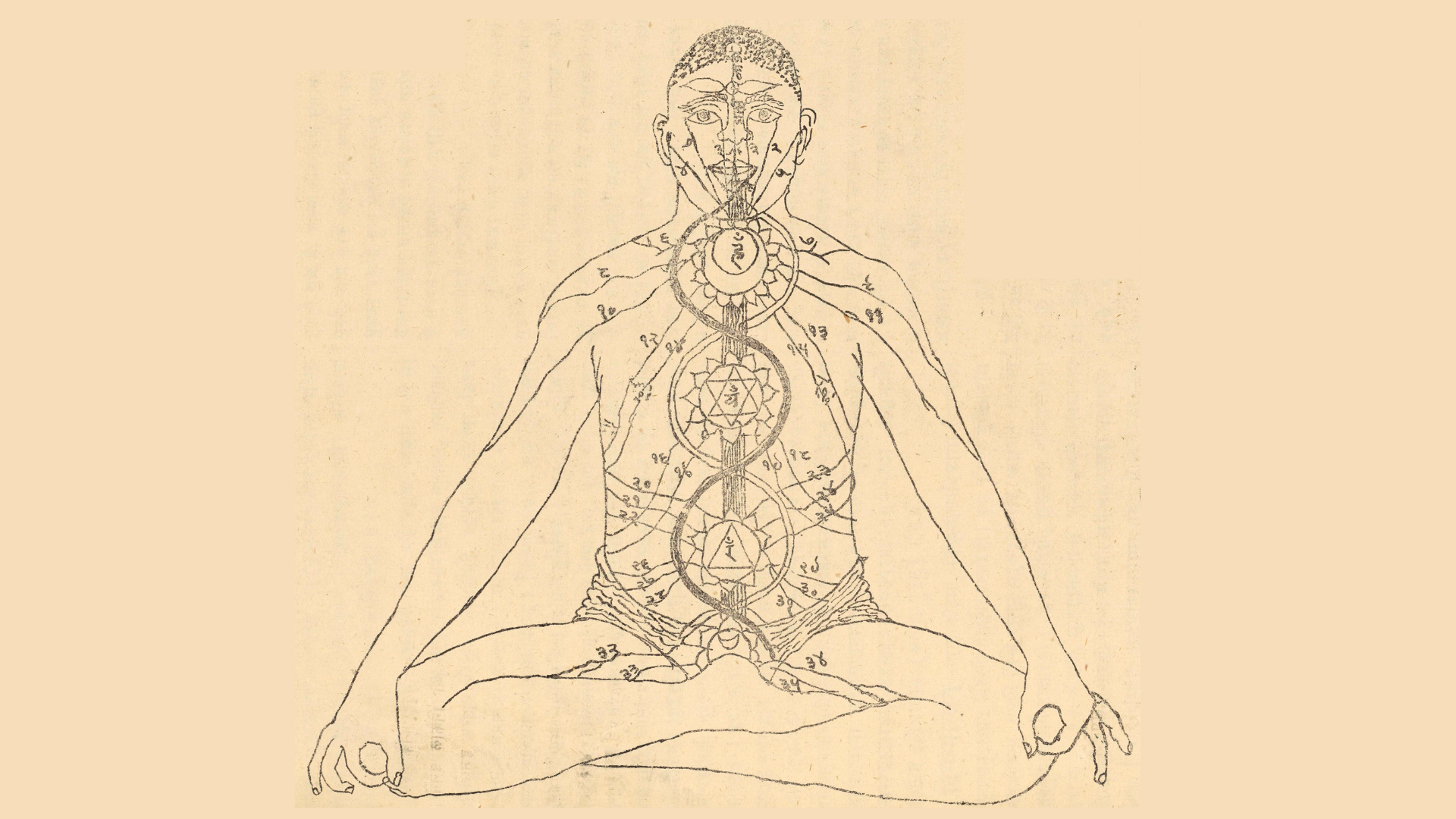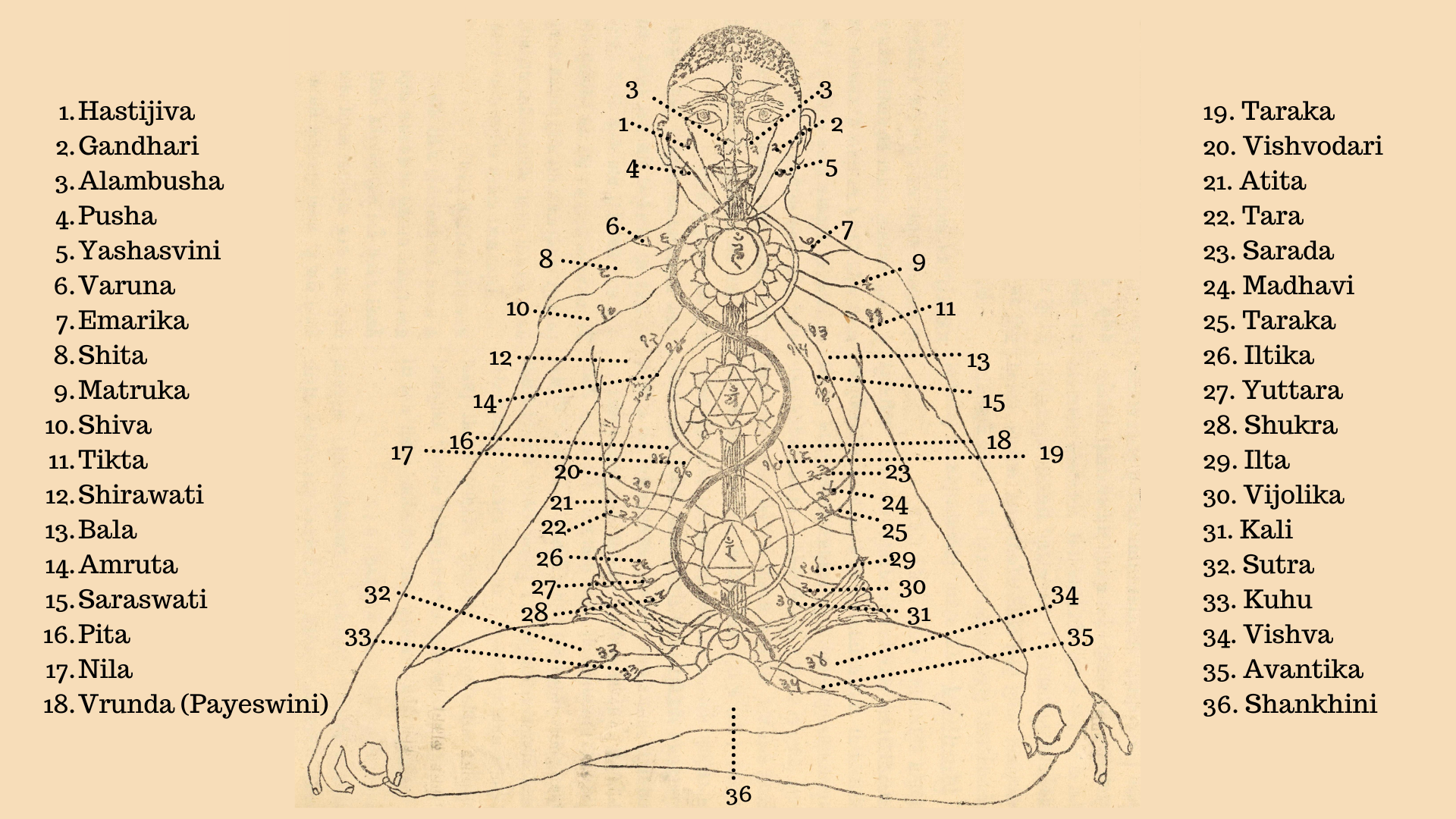Nadis: The 39 main energy channels and how they connect to the chakras.
By Devendra Narayan, PhD.

Image credit: Shatchakra niroopana chittra by Shri Swami Hansa Swaroop.
In this article you'll learn:
- The main 39 nadis (channels) of the energy body.
- Pathways of the nadis in relation to the physical body.
- Connection of the nadis with the chakras (energy centers).
prāṇaṃ devā anu prāṇanti . manuṣyāḥ paśavaśca ye . prāṇo hi bhūtānāmāyuḥ - Taittiriya Upanishad
Prana makes all animals, humans, and even devas (Gods) live. Therefore, Prana is life itself.
Prana, chakras and nadis are all parts of one coherent energy network. Prana is the life energy, which flows through your chakras. Nadis, conduct this life energy, and chakras are the points where this life energy is concentrated. Therefore, Prana, chakras and nadis are interconnected parts of your energy body.
While the knowledge and significance of chakras has grown over the years, the connection between Nadis and Chakras is one that most don't know about. In this article, I will discuss the 39 main Nadis of the human body and their connection to the Chakras as described in the Sanskrit text Shatchakra niroopana chittra a Hindi translation of which was recently made available by the Wellcome Library digital collection.
Let's begin with the three Nadis that have now become well known in yoga. Two nadis, the Ida and the Pingala, arise from Muladhara chakra (root chakra). The Moon channel, Ida, originates from the left side of the Muladhara, and the Sun channel, Pingala, originates from the right. A third channel, called the Sushumna, rises from the center of the Muladhara. It carries the brightness (tejas) of the moon, fire, and the sun. As it ascends the spinal column, it passes between the shoulder blades and reaches the crown of the head where it meets the Sahastrar chakra (crown chakra).
There are three other nadis within the Shushmna nadi, Vajra, Chitrini, and Brahma nadi. The original drawings of the Muladhara chakra and the three nadis residing within the Shushmna nadi from Satchakranirupa are shown below. Visualize these nadis as tubes within tubes.

Image: Muladhara chakra as seen in Shatchakra niroopana chittra by Shri Swami Hansa Swaroop. This image has been modified for use in this article.
Located within the Sushumna Nadi (1) is Vajra Nadi (2), which extends upwards from Muladhara Chakra to the crown. The Chitrini nadi (3), which pierces through all the energy centers, is located in the center of the Vajra nadi. It is thin like the string of a spider web. A fourth channel extends from the center of the Chitrini Nadi, called the Brahma Nadi (4), connecting the seven chakras like a string of pearls.
What are the 36 other nadis and their connection to the chakras?

Image: The 36 nadis of body as seen in Shatchakra niroopana chittra by Shri Swami Hansa Swaroop. This image has been modified for use in this article.
Let's now turn our attention to the 36 other nadis. A original schematic from Satchakranirupa of the human body with the 36 nadis, their connection to the chakras, and their pathway is shown in the figure. The following are the names and locations of the 36 channels:
1) Hastijiva - right eye
2) Gandhari - left eye
3) Alambusha - mouth (originating from the Ajna chakra)
4) Pusha - right ear
5) Yashasvini - left ear
6) Varuna - right collarbone (upper sternum)
7) Emarika - left collarbone (upper sternum)
8) Shita - below right collarbone (mid sternum)
9) Matruka - below left collarbone (mid sternum)
10) Shiva - below right collarbone (lower sternum)
11) Tikta - below left collarbone (lower sternum)
12) Shirawati - right mid chest
13) Bala - Left mid chest
14) Amruta - right lower chest
15) Saraswati - left lower chest
Concentrated in the shoulder and upper chest, channels 6 through 15 meet at the Vishuddhi chakra (Throat chakra).
16) Pita - upper right side of heart
17) Nila - lower right side of heart
18) Vrunda (Payeswini) - upper left side of heart
19) Taraka - lower left side of heart
Concentrated around the diaphragm region, channels 16 through 19 meets at the Anahata (Heart chakra)
20) Vishvodari - right upper abdomen
21) Atita - right upper abdomen
22) Tara - right upper abdomen
23) Sarada - left upper abdomen
24) Madhavi - left upper abdomen
25) Taraka - left upper abdomen
26) Iltika - right lower abdomen
27) Yuttara - right lower abdomen
28) Shukra - right lower abdomen
29) Ilta - left lower abdomen
30) Vijolika - left lower abdomen
31) Kali - left lower abdomen
Concentrated around the abdomen, channels 20 through 31 meets at the Manipura chakra (Solar plexus).
32) Sutra - right upper waist
33) Kuhu - right lower waist
34) Vishva - left upper waist
35) Avantika - left lower waist
Concentrated around the waist, channels 32 through 35 meet at the Swadhisthana Chakra (Sacral chakra)
36) Shankhini - This hidden channel originates from the Muladhara chakra to the Shastrara chakra. This nadi is not represented in the image but is a secret passage that connects the root and crown chakras.
Like small streams merging into rivers, the 36 nadis merge into Ida, Pingala, and Shushmna, which finally come together at the 3rd eye and merge into the thousand petal lotus (crown chakra). As a result, Ida, Pingala and Shushmna nadis are given the greatest attention in breathing practices as well as pranic healing because these nadis are the energy highways that carry the life energy from the 36 other nadis.
Some texts say there are 350,000 nadis, where do they come from?
If you do an internet search on nadis, you’ll learn that many articles and text mention 72,000 total nadis in the energy body. Some mention as many as 350,000 total nadis in the energy body. Let’s understand how these numbers came about.
In total, the 36 channels converge at the spinal column and from the top of the spinal column, split into two branches that enter the bones and other tissues. This results in 72 subchannels. According to the text Satchakranirupa, each subchannel is further divided into 1000 smaller sub-subchannels, making a total of 72,000 subtle energy channels. Akin to the circulatory system that carries oxygen-rich blood from the lungs to all parts of the body (via the heart) and then back to the lungs again, carrying CO2, the nadis also connect back to the spinal column at the base.
According to Satchakranirupa, except for the 2000 branches of Shankhini the other 70,000 branches further divide into 5 more sub-branches each, making a total of 350,000 subtle energy channels.
But here’s where the math does not add up.
350,000 + 2000 (sub-channels of Shankhini) + 3 (Ida, Pingala, Shushumna) + 3 (Vajra, Chitrini and Brahma nadi) = 352006 total nadis?
Regardless of the number of nadis in the body, it is important to realize that these are subtle channels, meaning they don't have gross anatomical manifestations like the nerves and blood vessels. Although understanding chakras and nadi systems in the context of human anatomy helps us learn about this ancient science of energy, it's more important to practice and experience this system and the benefits it offers.
In the same way that the flow of oxygen can be interrupted due to blockage in the blood vessels, the flow of prana can also be interrupted by blocked nadis. It is vital for the body (annamaya Kosha) as well as the mind (manomaya Kosha) that nadis be vibrant and clear. It is for this reason that there is a branch of yoga (Pranayama) dedicated to practices for cleansing the nadis. We will explore this practice and science of Pranayama in more detail in future articles.
So in summary, there are 39 main Nadis in the human energy body that divide to make up the network of 350,000 subtle channels. This article covered the names of the 39 main channels, their location in the body and connection with the chakras.
About the Author
Devendra Narayan is a scientist, yoga teacher, breathworker, scholar and founder of Cultivate Prana Academy. Cultivate Prana's mission is to empower modern day healers through education that integrates ancient wisdom and modern science.
Reference:
Svāmihaṃsasvarūpakr̥tam Ṣaṭcakranirūpaṇacitram : bhāṣyasamalaṃkr̥taṃ bhāṣāṭīkopetañ ca = Shatchakra niroopana chittra with bhashya and bhasha containing the pictures of the different nerves and plexuses of the human body with their full description showing the easiest method how to practise pranayam by the mental suspension of breath through meditation only ; by Shri Swami Hansa Swaroop.
-------
Copyright 2021 Cultivate Prana. All rights reserved.

